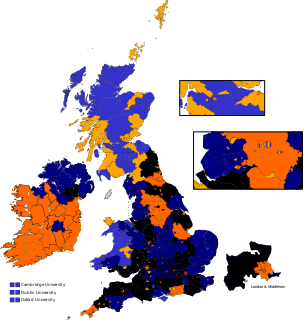Grantham was a Parliamentary constituency in Lincolnshire, England.

South Essex was a county constituency represented in the House of Commons of the Parliament of the United Kingdom from 1832 to 1885. It elected two Members of Parliament (MPs) using the bloc vote system.

North Cheshire is a former United Kingdom Parliamentary constituency. It was created upon the division of Cheshire in 1832. In 1868 it was abolished with South Cheshire to form East Cheshire, Mid Cheshire, West Cheshire and Stalybridge.
East Cheshire was parliamentary constituency which returned two Members of Parliament (MPs) to the House of Commons of the Parliament of the United Kingdom. Elections were held using the bloc vote system.

North Derbyshire was a Parliamentary constituency in the United Kingdom constituencies. It originally returned two Knights of the Shire to the House of Commons of the Parliament of the United Kingdom.
Hertford was the name of a parliamentary constituency in Hertfordshire, which elected Members of Parliament (MPs) from 1298 until 1974.
North Northamptonshire was a county constituency in Northamptonshire, represented in the House of Commons of the Parliament of the United Kingdom.

North Lincolnshire, formally known as the Northern Division of Lincolnshire or as Parts of Lindsey, was a county constituency in the Lindsey district of Lincolnshire. It returned two Members of Parliament (MPs) to the House of Commons of the Parliament of the United Kingdom.
West Staffordshire was a parliamentary constituency in Staffordshire which returned two Members of Parliament (MPs) to the House of Commons of the UK Parliament until 1885, and then one member.

North Lancashire was a county constituency of the House of Commons of the Parliament of the United Kingdom. It was represented by two Members of Parliament. The constituency was created by the Great Reform Act of 1832 by the splitting of Lancashire constituency into Northern and Southern divisions.

East Cumberland is a former county constituency in the House of Commons of the Parliament of the United Kingdom. It elected two Members of Parliament (MPs) by the bloc vote system of election.

West Kent was a county constituency in Kent in South East England. It returned two Members of Parliament (MPs) to the House of Commons of the Parliament of the United Kingdom, elected by the first past the post system.
Stamford was a constituency in the county of Lincolnshire of the House of Commons for the Parliament of England to 1706 then of the Parliament of Great Britain from 1707 to 1800 and of the Parliament of the United Kingdom from 1801 to 1918. It was represented by two Members of Parliament until 1868 when this was reduced to one.
EastEssex, formally known as the East Division of Essex was a parliamentary constituency in the English county of Essex. From 1868 to 1885, it returned two Members of Parliament (MPs) to the House of Commons of the Parliament of the United Kingdom, using the bloc vote system of election.

South Hampshire was a parliamentary constituency in the county of Hampshire, which returned two Members of Parliament (MPs) to the House of Commons of the Parliament of the United Kingdom, elected by the bloc vote system.

West Norfolk or Norfolk Western was a county constituency in the county of Norfolk, which returned two Members of Parliament (MPs) to the House of Commons of the Parliament of the United Kingdom, elected by the bloc vote system.
East Staffordshire or Staffordshire East was a county constituency in the county of Staffordshire. It returned two Members of Parliament (MPs) to the House of Commons of the Parliament of the United Kingdom, elected by the bloc vote system.
North Staffordshire was a county constituency in the county of Staffordshire. It returned two Members of Parliament (MPs) to the House of Commons of the Parliament of the United Kingdom, elected by the bloc vote system.
North Leicestershire, formally the "Northern Division of Leicestershire", was a county constituency represented in the House of Commons of the Parliament of the United Kingdom. It elected two Members of Parliament (MPs) by the bloc vote system of election.
Mid Lincolnshire, formally called the Mid Division of Lincolnshire, was a county constituency in Lincolnshire. It returned two Members of Parliament (MP) to the House of Commons of the Parliament of the United Kingdom, elected by the bloc vote electoral system.

